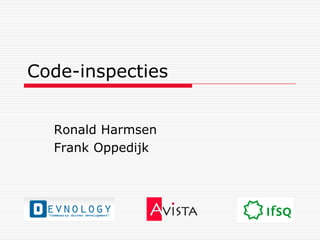
Code inspecties
- 1. Code-inspecties Ronald Harmsen Frank Oppedijk
- 2. Agenda Inleiding Introductie IfSQ-Level 1 (6 indicatoren) Hands-on: inspectie Level 1 Introductie IfSQ-Level 2 (12 indicatoren) Hands-on: inspectie Level 2 IfSQ-Level 2: nog 3 indicatoren Vragen & discussie
- 3. Waarom? Fouten vinden in bestaande code Fouten voorkómen – door verhoging van kwaliteit van toekomstige code Inzicht krijgen in betrouwbaarheid en onderhoudbaarheid
- 4. Voordelen en nadelen Geïnspecteerde software levert half zoveel rework op Geïnspecteerde software kost 90% minder onderhoud Inspectie vindt 60% meer fouten dan testen Inspectie is 4x meer effectief dan testen Developers die code inspecteren zijn minimaal 20% productiever Code-inspecties kosten tijd Code-inspecties zijn saai Code-inspecties kunnen negatief werken op de sfeer in het team
- 5. Soorten code-inspecties Formeel Lightweight
- 6. Formele code-inspectie Bijv. Fagan-inspecties Meerdere rollen en fasen Effectief Defect Removal Efficiency ~60% Ter vergelijking: DRE van testen: 35% Tijdrovend (sneuvelt daardoor vaak)
- 7. Lightweight code-inspectie Bijv. ‘walkthrough’, pair-programming Informeel Sneller Minder effectief (DRE ~50%) Minder efficiënt? (Formele inspecties meer gefocused; betere payoff)
- 8. IfSQ Formeel proces; objectief Snel Op papier
- 9. IfSQ: 3 levels Level-1: 6 indicatoren (1 min/pagina) Level-2: 12 (15) indicatoren (3 min/pagina) Level-3: 19 indicatoren (5 min/pagina)
- 10. IfSQ Level-1: indicatoren Work In Progress WIP-1—Vague "To Do" WIP-2—Disabled Code WIP-3—Empty Statement Block Structured Programming SP-1—Routine Too Long SP-2—Nesting Too Deep Single Point of Maintenance SPM-1—Magic Numbers
- 12. IfSQ Level-1: hands-on Voer inspectie uit op uitgereikte code Level-1 20 minuten Noot: indicatoren Level-1 staan in boekje en op Quick Reference Card
- 13. IfSQ Level-1: hands-on Resultaten code-inspectie: WIP-1—Vague "To Do":2 WIP-2—Disabled Code: 38 WIP-3—Empty Statement Block: 5 SP-1—Routine Too Long: 10 SP-2—Nesting Too Deep: 0 SPM-1—Magic Numbers: 31
- 14. IfSQ Level-2: 6 extra indicatoren Structured Programming SP-3—Routine Too Complex Single Point of Maintenance SPM-2—Magic Strings SPM-3—Copy/Paste Programming Defensive Programming DP-1—Parameter Not Checked DP-2—Status Ignored After Call DP-3—Unexpected State Not Trapped
- 16. IfSQ Level-2: hands-on Voer inspectie uit op zelf meegebrachte code Level-2 30 minuten Noot: indicatoren Level-2 staan op Quick Reference Card
- 17. IfSQ Level-2: rating Bereken defect indicators per 1000 LOC Bepaal vervolgens de rating: count/kLOC (min.) count/kLOC (max.) rating 0 0 10 1 1 9 2 4 8 5 9 7 10 19 6 20 49 5 50 99 4 100 199 3 200 499 2 500 999 1 1000 unlimited 0
- 18. IfSQ Level-2 Nog 3 indicatoren Minder objectief CfC-NC—Not Complete CfC-WR—Wrong Result CfC-HtM—Hard to Maintain
- 19. Vragen?
